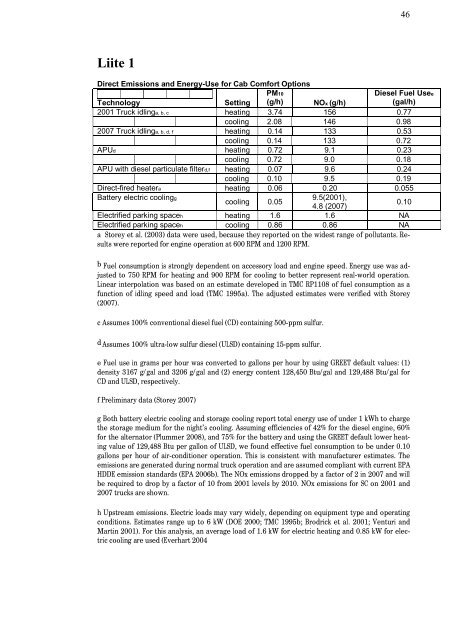Katsaus ajoneuvojen oheisjärjestelmien ... - TransEco
Katsaus ajoneuvojen oheisjärjestelmien ... - TransEco
Katsaus ajoneuvojen oheisjärjestelmien ... - TransEco
Create successful ePaper yourself
Turn your PDF publications into a flip-book with our unique Google optimized e-Paper software.
46Liite 1Direct Emissions and EnergyUse for Cab Comfort OptionsTechnologySettingPM10(g/h) NOx (g/h)Diesel Fuel Usee(gal/h)2001 Truck idlinga, b, c heating 3.74 156 0.77cooling 2.08 146 0.982007 Truck idlinga, b, d, f heating 0.14 133 0.53cooling 0.14 133 0.72APUd heating 0.72 9.1 0.23cooling 0.72 9.0 0.18APU with diesel particulate filterd,f heating 0.07 9.6 0.24cooling 0.10 9.5 0.19Directfired heatera heating 0.06 0.20 0.055Battery electric coolingg9.5(2001),cooling 0.054.8 (2007)0.10Electrified parking spaceh heating 1.6 1.6 NAElectrified parking spaceh cooling 0.86 0.86 NAa Storey et al. (2003) data were used, because they reported on the widest range of pollutants. Resultswere reported for engine operation at 600 RPM and 1200 RPM.b Fuel consumption is strongly dependent on accessory load and engine speed. Energy use was adjustedto 750 RPM for heating and 900 RPM for cooling to better represent realworld operation.Linear interpolation was based on an estimate developed in TMC RP1108 of fuel consumption as afunction of idling speed and load (TMC 1995a). The adjusted estimates were verified with Storey(2007).c Assumes 100% conventional diesel fuel (CD) containing 500ppm sulfur.d Assumes 100% ultralow sulfur diesel (ULSD) containing 15ppm sulfur.e Fuel use in grams per hour was converted to gallons per hour by using GREET default values: (1)density 3167 g/gal and 3206 g/gal and (2) energy content 128,450 Btu/gal and 129,488 Btu/gal forCD and ULSD, respectively.f Preliminary data (Storey 2007)g Both battery electric cooling and storage cooling report total energy use of under 1 kWh to chargethe storage medium for the night’s cooling. Assuming efficiencies of 42% for the diesel engine, 60%for the alternator (Plummer 2008), and 75% for the battery and using the GREET default lower heatingvalue of 129,488 Btu per gallon of ULSD, we found effective fuel consumption to be under 0.10gallons per hour of airconditioner operation. This is consistent with manufacturer estimates. Theemissions are generated during normal truck operation and are assumed compliant with current EPAHDDE emission standards (EPA 2006b). The NOx emissions dropped by a factor of 2 in 2007 and willbe required to drop by a factor of 10 from 2001 levels by 2010. NOx emissions for SC on 2001 and2007 trucks are shown.h Upstream emissions. Electric loads may vary widely, depending on equipment type and operatingconditions. Estimates range up to 6 kW (DOE 2000; TMC 1995b; Brodrick et al. 2001; Venturi andMartin 2001). For this analysis, an average load of 1.6 kW for electric heating and 0.85 kW for electriccooling are used (Everhart 2004
















